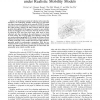Free Online Productivity Tools
i2Speak
i2Symbol
i2OCR
iTex2Img
iWeb2Print
iWeb2Shot
i2Type
iPdf2Split
iPdf2Merge
i2Bopomofo
i2Arabic
i2Style
i2Image
i2PDF
iLatex2Rtf
Sci2ools
104
Voted
WCNC
2008
IEEE
2008
IEEE
Performance Evaluation of Vehicular DTN Routing under Realistic Mobility Models
—In performance studies of vehicular ad hoc networks (VANETs), the underlying mobility model plays an important role. Since conventional mobile ad hoc network (MANET) routing protocols do not work efficiently in vehicular environments due to the rapid topology changes, the Delay-Tolerant Network (DTN) model is often applied. In this paper, we construct a new mobility model, the Shanghai Urban Vehicular Network (SUVnet) model by using the GPS data from more than 4,000 taxis we have collected, and then investigate the performance of two kinds of DTN routing, the non-geographic pure epidemic routing and our newly-proposed geographic DTN routing, the Distance-Aware Epidemic Routing (DAER). We use the popular random waypoint mobility model and a more complex microscopic traffic simulator generated model for performance comparison. With the two considered DTN routing protocols, conventional mobility models tend to give higher performance results than SUVnet model, the presumably more rea...
Related Content
| Added | 01 Jun 2010 |
| Updated | 01 Jun 2010 |
| Type | Conference |
| Year | 2008 |
| Where | WCNC |
| Authors | Pei'en Luo, Hongyu Huang, Wei Shu, Minglu Li, Min-You Wu |
Comments (0)

